




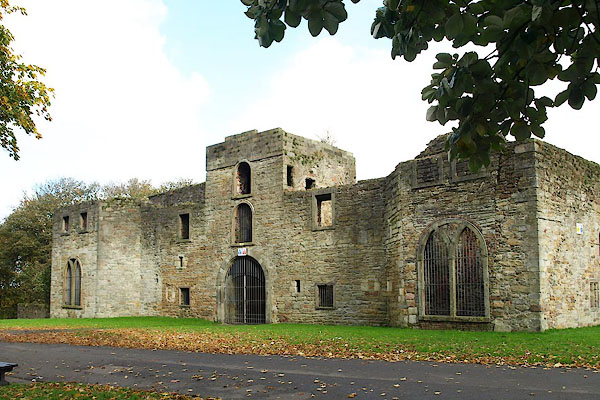
BPT69.jpg (taken 22.10.2008)

BPT70.jpg (taken 22.10.2008)
placename:- Workington Hall
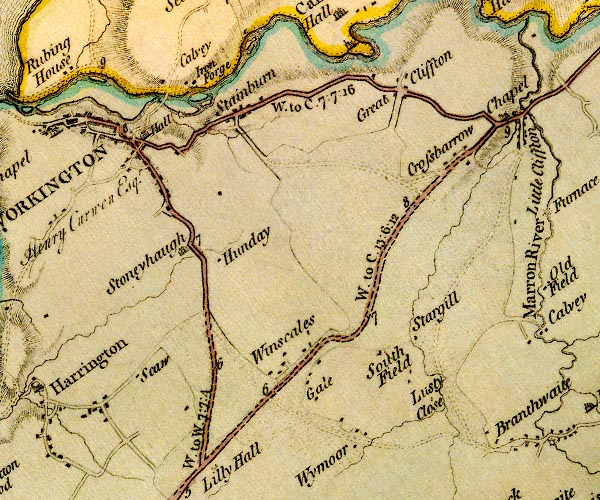
D4NY02NW.jpg
"Hall / Henry Curwen Esqr."
house
item:- Carlisle Library : Map 2
Image © Carlisle Library
placename:- Workington Hall
 goto source
goto sourcePages 23-24:- "... ..."
"Workington Bank ... On the W. end of this shoal, St. Bee's Head bears S. by W. ½W. Workington Hall S.S.E. and in a line with Winsgil's (which is the north-most of three small clumps of wood that may be seen on the top of a rising ground, about three miles S. of Workington), and Mary-Port E. by S. ..."
placename:- Workington Castle
 goto source
goto sourcePage 105:- "..."
"I do not find any ancient authors mention a castle here [Castlerigg], Speed, who speaks of twenty-five in Cumberland, hath found out every one I ever heard or knew of, except Kirkoswald; how that has escaped him I cannot tell. I shall here put down their names, and, as well as I can, their most ancient owners, and supposed founders."
"..."
 goto source
goto sourcePage 106:- "..."
"23. WORKINGTON. The Culwens, now Curwens, no place there now called Castle."
"..."
 goto source
goto sourcePage 138:- "... miss Curwen of Workington-Hall in the county of Cumberland, being the last of that name there."
"Of this ancient family Mr Cambden says he himself descended by the mother's side, and who, according to that author, "fetch their descent from Gospatrick Earl of Northumberland; and they took their surname from Culwen, a family in Galloway in Scotland, the heir whereof they had married." It is very likely they were of Scottish extraction, for Mary Queen of Scots fled hither. They are the most ancient family in Cumberland that I know of; always residing there, and always having male-heirs till now. ..."
placename:- Workington Hall
item:- elections; coat of arms
 goto source
goto sourcePage 184:- "..."
"The Curwen family is a very antient and respectable one. Their principal residence has long been at Workington hall in the county of Cumberland, where they had large possessions in landed property and coal mines. The last gentleman of that name and family was Henry Curwen, esq.; late member for the county. It was chiefly by his interest that sir James Lowther, now earl of Lonsdale, lost his parliamentary interest in the famous contested election for Cumberland in the year 1768, when Henry Fletcher, esq; now a baronet, first obtained a seat in the House of Commons in conjunction with Mr. Curwen, who sat in the preceding parliament for the city of Carlisle. He left an only daughter, heiress to all his large possessions, who was married about three years ago, very young, to her paternal first cousin John Christian, esq; of Unerigg hall in the same county. It is remarkable of this lady, that she was the last and only living child of a great number, her mother, the late Mrs. Curwen, formerly Miss Gale, of Whitehaven, having had fifteen or more children, previous to the present lady, all either still born or that died within a few minutes after their birth."
"On a pillar at the south-east end of the minster at Lincoln is fixed a small square marble slab with this inscription:"
""Here lieth Anne Curwen, daughter of sir
Nicholas Curwen, of Workington in the
county of Cumberland, knt. who died the
XIII of April 1606, aet. 21.""
"Arms in a lozenge, Arg. FrettèG a chief Az. Crest on a torse a horse passant."
"The mansion-house is a large quadrangular building, which still bears marks of great antiquity, notwithstanding various alterations and improvements, which have been made duting the last thirty years. The walls are so remarkably thick, that they were able, a few years since, in making some improvements to excavate a passage sufficiently wide lengthways through one of the walls, leaving a proper thickness on each side of the passage to answer every purpose of strength."
"It was within a very short distance of this house where the river Darwent empties itself into the sea that the unhappy Mary queen of Scots landed in 1568, after her escape from the castle of Dunbar, and subsequent defeat. She took refuge at this house, and was hospitably entertained by sir Henry Curwen, till the pleasure of Elizabeth was known; when she was removed first to Cockermouth castle and then to Carlisle. The chamber in which she slept at Workington hall is still called the Queen's chamber."
"We have before seen that Horsley removes ARBEIA to Moresby, which others had placed at Workington on no better authority than the Burrough walls, about a mile from the town, which are still standing, though no more than one of those old towers so common in the north, and sometimes called Burgh or Brugh; but it has no other evidences of its having been a Roman station."
"The rectory of Workington, worth 400£. per ann. is held by Mr. William Thomas Addison, who married a sister of Mr. Curwen, his patron, and has a son in the East-Indies."
placename:- Workington Hall
 goto source
goto source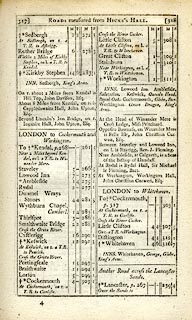 click to enlarge
click to enlargeC38317.jpg
page 317-318 "At Workington, Workington Hall, John Christian Curwen, Esq."
item:- JandMN : 228.1
Image © see bottom of page
placename:- Workington Hall
 goto source
goto source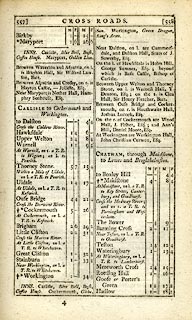 click to enlarge
click to enlargeC38557.jpg
page 557-558 "At Workington are Workington Hall, John Christian Curwen, Esq."
item:- JandMN : 228.2
Image © see bottom of page
placename:- Workington Hall
 goto source
goto sourcePage 173:- "..."
"... On the east side of the town is Workington Hall, the manor-house of the ancient family of Curwen, finely situated on an elevated position above the river. It is remarkable as having afforded an asylum to the unfortunate and persecuted Mary Queen of Scots, when she landed at Workington. ..."
placename:- Wirkyngton
item:- licence to crenellate
 goto source
goto sourceGentleman's Magazine 1856 part 2 pp.467-475 "..."
"LICENCES TO CRENELLATE, FROM THE PATENT ROLLS IN THE TOWER OF LONDON. (Continued from p.330.)"
"..."
"RICHARD II. A.D. 1377. June 22. 1399. Sep. 29."
"3. Gilbertus de Culwen, miles domum apud maneriuma Wirkyngtonb ... Cumbr."
"..."
"a The Roll explains "quandam domum per ipsum ut dicit apud manerium suum de Wirkyngton in Com. Cumbr. juxta Marchiam Scociae muro de petra et calce edificatam firmare et kernellare," &c. b Wigton?"
"..."
item:- licence to crenellate
Licence to crenellate granted by Edward III, 4 Marh 1380:- "Gilbertus de Culwen, miles quondam ... domum per ipsum ut dicit apud manerium ... suum de Wyrkyngton, Cumberland, juxta Marchiam Scotiae ..."
placename:- Workington Hall
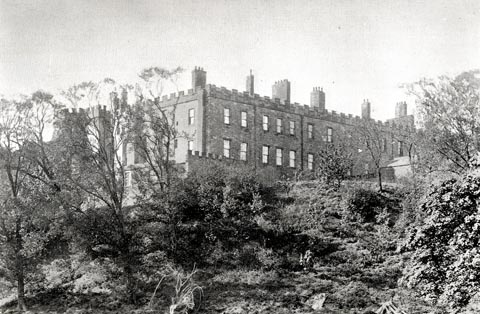 click to enlarge
click to enlargeCW0146.jpg
Tipped in opposite p.244 of The Castles and Fortified Towers of Cumberland, Westmorland, and Lancashire North of the Sands, by John F Curwen.
printed at bottom:- "WORKINGTON HALL, FROM THE NORTH-EAST."
item:- Armitt Library : A782.46
Image © see bottom of page
placename:- Workington Hall
item:- coat of arms
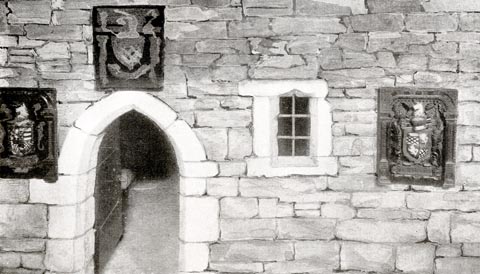 click to enlarge
click to enlargeCW0148.jpg
Tipped in opposite p.247 of The Castles and Fortified Towers of Cumberland, Westmorland, and Lancashire North of the Sands, by John F Curwen.
printed at lower right:- "WORKINGTON HALL: ENTRANCE TO CELLARS"
item:- Armitt Library : A782.48
Image © see bottom of page
placename:- Workington Hall
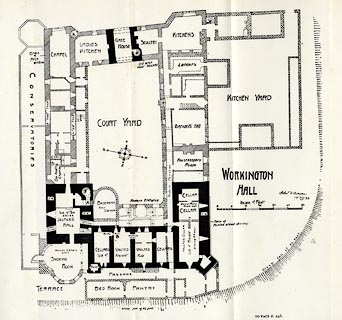 click to enlarge
click to enlargeCW0147.jpg
Tipped in opposite p.246 of The Castles and Fortified Towers of Cumberland, Westmorland, and Lancashire North of the Sands, by John F Curwen.
printed at lower right:- "WORKINGTON / HALL"
printed at lower right:- "John F. Curwen / 17.viij.99"
item:- Armitt Library : A782.47
Image © see bottom of page
placename:- Workington Hall
courtesy of English Heritage
"WORKINGTON HALL / / HALL BROW / WORKINGTON / ALLERDALE / CUMBRIA / I / 72269 / NY0078728813"
courtesy of English Heritage
"Fortified tower house with various additions, now in ruins. Mid C14 with C15 and C16 alterations and additions; late 1783-1789 additions by John Carr for the Curwen family. Mixed large blocks of red and calciferous sandstone with additions of similar rubble stone, all without roofs; oldest parts on chamfered plinth. Rectangular 3-storey tower with adjoining L-shaped medieval wing reduced to single-storey and rebuilt as 3 storeys by Carr; also adjoined by C15 hall range of 2 storeys, 5 bays, all enclosing courtyard on 2 sides, the quadrangle completed by a medieval gatehouse tower and wing by Carr. Tower was extensively renovated by Carr but retains some original loops, internal spiral staircase and mural chambers. Late C18 round and flat-headed windows, all unglazed. Wing has projecting 3-storey garderobe turret and ground-floor loops; large first-floor late C18 round-headed window openings, those above in ruins. Late C18 canted bay window to left. Further right-angled kitchen range of similar details, with angle turret. Hall range has blocked windows and doorways of various dates; 2 ground-floor early C16 2-light windows and upper-floor C15 window. Inner wall has C15 doorways and blocked early C16 multi-light windows. 3-storey gatehouse has flanking guardrooms with angle turret to right, showing a number of small original chamfered-surround windows; the round-headed through archway and windows are late C18 alterations. Adjoining late C18 wing has similar flat-headed window openings. Ancestral home of the Curwen family who obtained a licence to crenellate in 1380 (the foundation stone for the tower is said to have been laid 8 May 1362) and owned by them until sold to the local council mid C20. After vandalisation the council reduced the building to a controlled ruin. See Tom Clare, Report on the Fortified Buildings of Cumbria, Cumbria County Council, 1983 (unpublished), appendix 3; Transactions Cumberland Westmorland Antiquarian & Archaeological Society, old series, xvi, 1-15; J.F. Curwen, Castles &Towers, 1913, 244-7."
courtesy of English Heritage
"GATEPIERS SOUTH EAST OF WORKINGTON HALL / / RAMSAY BROW / WORKINGTON / ALLERDALE / CUMBRIA / II / 72294 / NY0086228607"
courtesy of English Heritage
"Gate piers for Workington Hall. Late C18 for the Curwen family. Calciferous sandstone ashlar. Square piers surmounted by armorial carved stone unicorn heads (crests of the Curwen family). Flanking wall is rebuilt and not of interest. Listed for G.V. with Workington Hall."
placename:- Hall, The
 click to enlarge
click to enlargeJL09Vgn1.jpg
"S.E. View of the Hall."
item:- Armitt Library : A214.6
Image © see bottom of page
placename:- Hall, The
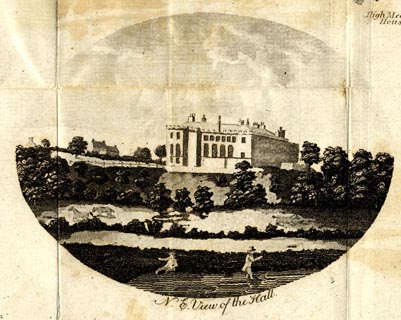 click to enlarge
click to enlargeJL09Vgn2.jpg
"N.E. View of the Hall."
item:- Armitt Library : A214.6
Image © see bottom of page
 click to enlarge
click to enlargePR1424.jpg
John Christian Curwen standing in front of Workington Hall.
signed at bottom right on print:- "Simpson"
 click to enlarge
click to enlargePR1425.jpg
text by T Gray about John Christian Curwen of Workington Hall on reverse of coloured print by Joseph W Simpson, 1934.
item:- Tullie House Museum : 2009.210.6
Images © Tullie House Museum
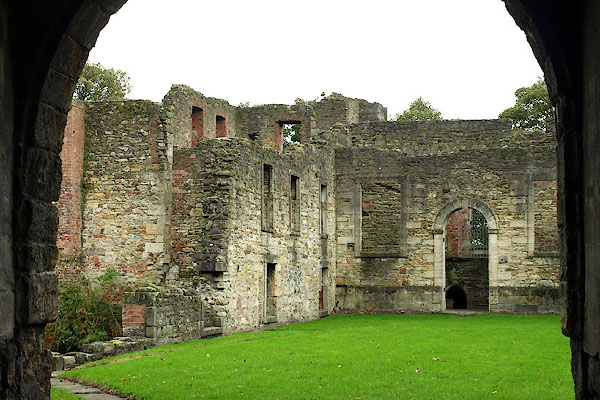
BPT71.jpg (taken 22.10.2008)

CDU15.jpg Gateway at,
(taken 4.9.2015)

CDU16.jpg Cast iron unicorn on gate pier,
(taken 4.9.2015)
